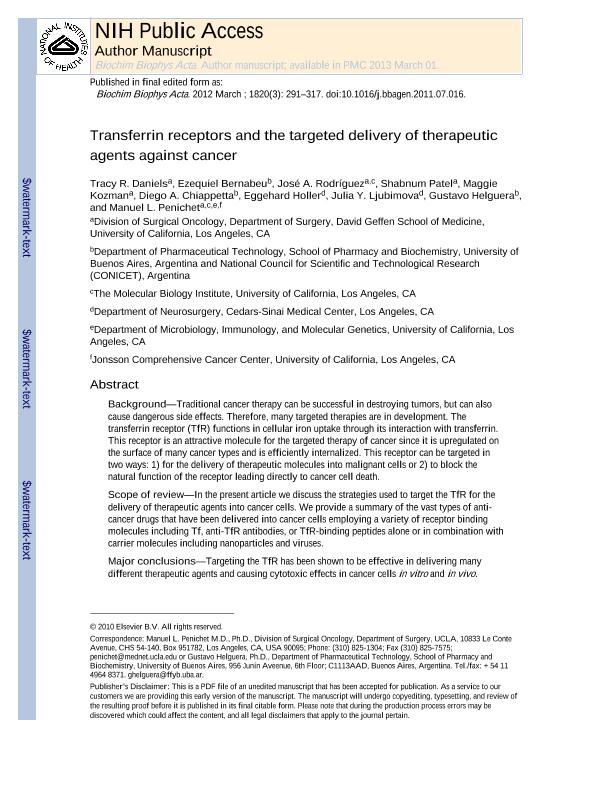Mostrar el registro sencillo del ítem
dc.contributor.author
Daniels, Tracy R.
dc.contributor.author
Bernabeu, Ezequiel Adrian

dc.contributor.author
Rodríguez, José A.
dc.contributor.author
Patel, Shabnum
dc.contributor.author
Kozman, Maggie
dc.contributor.author
Chiappetta, Diego Andrés

dc.contributor.author
Holler, Eggehard
dc.contributor.author
Ljubimova, Julia Y.
dc.contributor.author
Helguera, Gustavo Fernando

dc.contributor.author
Penichet, Manuel L.
dc.date.available
2017-03-21T20:14:26Z
dc.date.issued
2012-03
dc.identifier.citation
Daniels, Tracy R.; Bernabeu, Ezequiel Adrian; Rodríguez, José A.; Patel, Shabnum; Kozman, Maggie; et al.; The transferrin receptor and the targeted delivery of therapeutic agents against cancer; Elsevier Science; Biochimica Et Biophysica Acta- General Subjects; 1820; 3; 3-2012; 291-317
dc.identifier.issn
0304-4165
dc.identifier.uri
http://hdl.handle.net/11336/14137
dc.description.abstract
Background: Traditional cancer therapy can be successful in destroying tumors, but can also cause dangerous side effects. Therefore, many targeted therapies are in development. The transferrin receptor (TfR) functions in cellular iron uptake through its interaction with transferrin. This receptor is an attractive molecule for the targeted therapy of cancer since it is upregulated on the surface of many cancer types and is efficiently internalized. This receptor can be targeted in two ways: 1) for the delivery of therapeutic molecules into malignant cells or 2) to block the natural function of the receptor leading directly to cancer cell death. Scope of revie: In the present article we discuss the strategies used to target the TfR for the delivery of therapeutic agents into cancer cells. We provide a summary of the vast types of anti-cancer drugs that have been delivered into cancer cells employing a variety of receptor binding molecules including Tf, anti-TfR antibodies, or TfR-binding peptides alone or in combination with carrier molecules including nanoparticles and viruses. Major conclusions: Targeting the TfR has been shown to be effective in delivering many different therapeutic agents and causing cytotoxic effects in cancer cells in vitro and in vivo. General significance: The extensive use of TfR for targeted therapy attests to the versatility of targeting this receptor for therapeutic purposes against malignant cells. More advances in this area are expected to further improve the therapeutic potential of targeting the TfR for cancer therapy leading to an increase in the number of clinical trials of molecules targeting this receptor. This article is part of a Special Issue entitled Transferrins: molecular mechanisms of iron transport and disorders.
dc.format
application/pdf
dc.language.iso
eng
dc.publisher
Elsevier Science

dc.rights
info:eu-repo/semantics/openAccess
dc.rights.uri
https://creativecommons.org/licenses/by-nc-nd/2.5/ar/
dc.subject
Transferrin Receptor
dc.subject
Cancer
dc.subject
Nanoparticle
dc.subject
Immnunotoxin
dc.subject
Delivery
dc.subject
Conjugate
dc.subject.classification
Otras Nanotecnología

dc.subject.classification
Nanotecnología

dc.subject.classification
INGENIERÍAS Y TECNOLOGÍAS

dc.title
The transferrin receptor and the targeted delivery of therapeutic agents against cancer
dc.type
info:eu-repo/semantics/article
dc.type
info:ar-repo/semantics/artículo
dc.type
info:eu-repo/semantics/publishedVersion
dc.date.updated
2017-03-20T17:40:59Z
dc.journal.volume
1820
dc.journal.number
3
dc.journal.pagination
291-317
dc.journal.pais
Países Bajos

dc.journal.ciudad
Ámsterdam
dc.description.fil
Fil: Daniels, Tracy R.. University of California at Los Angeles; Estados Unidos
dc.description.fil
Fil: Bernabeu, Ezequiel Adrian. Consejo Nacional de Investigaciones Científicas y Técnicas; Argentina. Universidad de Buenos Aires. Facultad de Farmacia y Bioquímica. Departamento de Tecnología Farmacéutica; Argentina
dc.description.fil
Fil: Rodríguez, José A.. University of California at Los Angeles; Estados Unidos
dc.description.fil
Fil: Patel, Shabnum. University of California at Los Angeles; Estados Unidos
dc.description.fil
Fil: Kozman, Maggie. University of California at Los Angeles; Estados Unidos
dc.description.fil
Fil: Chiappetta, Diego Andrés. Consejo Nacional de Investigaciones Científicas y Técnicas; Argentina. Universidad de Buenos Aires. Facultad de Farmacia y Bioquímica. Departamento de Tecnología Farmacéutica; Argentina
dc.description.fil
Fil: Holler, Eggehard. Cedars Sinai Medical Center; Estados Unidos
dc.description.fil
Fil: Ljubimova, Julia Y.. Cedars Sinai Medical Center; Estados Unidos
dc.description.fil
Fil: Helguera, Gustavo Fernando. Consejo Nacional de Investigaciones Científicas y Técnicas; Argentina. Universidad de Buenos Aires. Facultad de Farmacia y Bioquímica. Departamento de Tecnología Farmacéutica; Argentina
dc.description.fil
Fil: Penichet, Manuel L.. University of California at Los Angeles; Estados Unidos
dc.journal.title
Biochimica Et Biophysica Acta- General Subjects

dc.relation.alternativeid
info:eu-repo/semantics/altIdentifier/url/http://www.sciencedirect.com/science/article/pii/S0304416511001826
dc.relation.alternativeid
info:eu-repo/semantics/altIdentifier/doi/http://dx.doi.org/10.1016/j.bbagen.2011.07.016
dc.relation.alternativeid
info:eu-repo/semantics/altIdentifier/url/https://www.ncbi.nlm.nih.gov/pmc/articles/PMC3500658/
Archivos asociados
